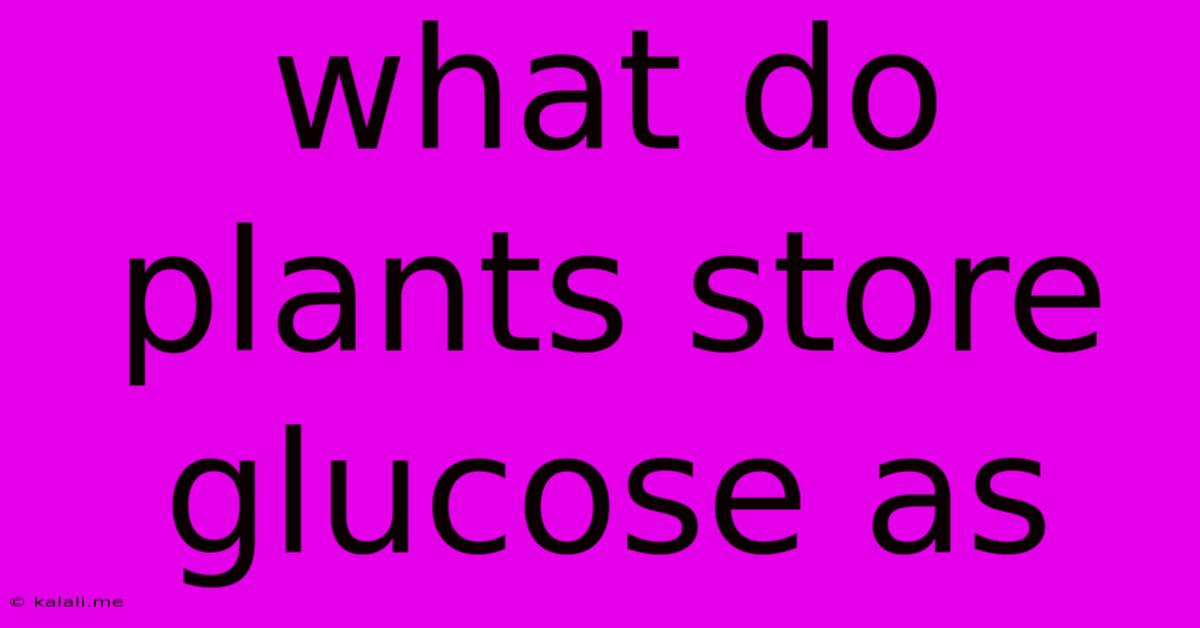What Do Plants Store Glucose As
Kalali
Jun 14, 2025 · 3 min read

Table of Contents
What Do Plants Store Glucose As? Unpacking the Secrets of Plant Carbohydrate Storage
Plants, the silent powerhouses of our ecosystem, are masters of energy conversion. Through the process of photosynthesis, they harness sunlight to create glucose, their primary source of energy. But unlike us, plants don't just burn this glucose immediately. They cleverly store it for later use, employing various ingenious strategies depending on the plant species and the specific needs of its tissues. This article will explore the primary ways plants store glucose, shedding light on the fascinating world of plant carbohydrate metabolism.
Plants primarily store glucose in two main forms: starch and sucrose. These forms offer different advantages, tailored to the plant's specific requirements for energy storage and transport. Let's delve into the details of each.
Starch: The Long-Term Energy Reserve
Starch is the most common way plants store excess glucose. This complex carbohydrate is a polysaccharide, meaning it's made up of long chains of glucose molecules. It's essentially a highly efficient way to package a large amount of energy into a compact form. Think of it as the plant's pantry, stocked with long-term energy reserves.
There are two main types of starch:
- Amylose: A linear chain of glucose molecules, forming a helical structure.
- Amylopectin: A branched chain of glucose molecules, providing more points of enzymatic attack for easier and quicker energy release when needed.
Starch granules, which are essentially packets of amylose and amylopectin, are stored in various plant parts, most notably in:
- Seeds: Seeds like grains (wheat, rice, corn), legumes (beans, peas), and nuts are rich in starch, providing energy for germination and seedling growth. This is a critical energy source for the plant's initial growth phase.
- Roots: Many plants, like potatoes and sweet potatoes, store large amounts of starch in their roots as a reserve for periods of low sunlight or during winter dormancy. This underground storage allows the plant to survive and regrow the following season.
- Fruits: Some fruits, such as bananas and apples, contain starch that converts to sugars as the fruit ripens. This sweetness attracts animals, aiding in seed dispersal.
Sucrose: The Mobile Energy Currency
While starch serves as the long-term storage solution, sucrose plays a different, equally crucial role. Sucrose, a disaccharide composed of glucose and fructose, acts as the plant's primary transport carbohydrate. It's like the plant's delivery system, efficiently moving energy between different parts of the plant.
Sucrose is readily soluble in water, allowing it to be easily transported through the plant's vascular system (xylem and phloem). It's produced in the leaves during photosynthesis and then transported to other parts of the plant where it's either used immediately for energy or converted into starch for storage. This makes sucrose vital for:
- Energy distribution: Supplying energy to growing tissues, roots, and flowers.
- Signal transduction: Acting as a signaling molecule, influencing various plant processes.
Other Forms of Glucose Storage (less common):
While starch and sucrose are the dominant forms, some plants employ other mechanisms:
- Fructans: Certain plants, especially those in colder climates, store glucose as fructans, a type of fructo-oligosaccharide.
- Inulin: A type of fructan found in plants like chicory and Jerusalem artichoke.
Ultimately, the specific method a plant employs to store glucose depends on several factors, including its evolutionary history, environmental conditions, and its growth strategy. The ability to effectively store and mobilize glucose is crucial for plant survival and reproduction, ensuring their continued success in diverse ecosystems. Understanding these processes is crucial not only for basic botany but also for applications in agriculture and biotechnology, aiming to improve crop yields and develop new sustainable energy sources.
Latest Posts
Latest Posts
-
What Is The Lcm Of 4 9 And 12
Jun 14, 2025
-
What Is The Least Viscous Liquid
Jun 14, 2025
-
What Group In The Periodic Table Is Least Reactive
Jun 14, 2025
-
Moment Of Inertia For Rectangular Beam
Jun 14, 2025
-
Least Common Multiple Of 8 And 30
Jun 14, 2025
Related Post
Thank you for visiting our website which covers about What Do Plants Store Glucose As . We hope the information provided has been useful to you. Feel free to contact us if you have any questions or need further assistance. See you next time and don't miss to bookmark.